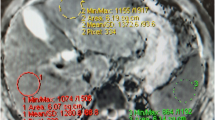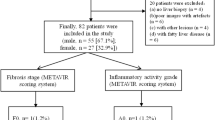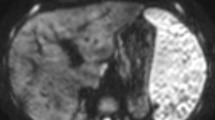Abstract
Purpose
This study was done to prospectively evaluate the usefulness of apparent diffusion coefficient (ADC) in the diagnosis and grading of hepatic fibrosis and inflammation in children with chronic hepatitis.
Materials and methods
Institutional Review Board approval was obtained. This prospective study was carried out on 50 children with chronic hepatitis (mean age 8.3 ± 3.2 years; 33 boys and 17 girls) and 20 age- and sex-matched healthy control children. The children underwent diffusion-weighted magnetic resonance imaging of the liver. The ADC value of the liver was calculated. The hepatic fibrosis stages (F1–F6) and necroinflammatory activity grades (A1–A4) were calculated. The ADC values of different stages of hepatic fibrosis and grades of necroinflammatory activity were calculated.
Results
The mean ADC value of the liver parenchyma was 1.53 ± 0.17 × 10−3 mm2/s in children with chronic hepatitis and 1.74 ± 0.16 × 10−3 mm2/s in controls. The ADC value was significantly lower in children with hepatic fibrosis compared to controls (p = 0.001). There was a significant difference (p = 0.001) in ADC between mild (F1–F3) and advanced (F4–F6) stages of fibrosis. There was a significant difference (p = 0.004) in ADC between mild (A1–A2) and advanced (A3–A4) grades of necroinflammation. The cut-off ADC values used to differentiate mild from advanced fibrosis and necroinflammation were 1.62 and 1.64 mm2/s with an area under the curve of 0.898 and 0.807, respectively. The ADC value negatively correlated with stages of hepatic fibrosis (r = −0.799, p = 0.001) and necroinflammatory activity grade (r = −0.468, p = 0.001).
Conclusions
We conclude that ADC value is an effective noninvasive parameter for the diagnosis and grading of hepatic fibrosis and inflammation in children with chronic hepatitis.






Similar content being viewed by others
References
Yoshioka K, Hashimoto S (2012) Can non-invasive assessment of liver fibrosis replace liver biopsy? Hepatol Res 42:233–240
Martínez S, Crespo G, Navasa M et al (2011) Noninvasive assessment of liver fibrosis. Hepatology 53:325–335
Castera L (2011) Non-invasive assessment of liver fibrosis in chronic hepatitis C. Hepatol Int 5:625–634
Kim SU, Han KH, Ahn SH (2011) Non-invasive assessment of liver fibrosis: the gap between ideal and real. J Gastroenterol Hepatol 26:937–939
Germani G, Hytiroglou P, Fotiadu A et al (2011) Assessment of fibrosis and cirrhosis in liver biopsies: an update. Semin Liver Dis 31:82–90
Goodman ZD (2007) Grading and staging systems for inflammation and fibrosis in chronic liver diseases. J Hepatol 47:598–607
Chou R, Wasson N (2013) Blood tests to diagnose fibrosis or cirrhosis in patients with chronic hepatitis C virus infection: a systematic review. Ann Intern Med 158:807–820
Fiorini E, Cipriano V, De Molo C et al (2012) Real-time elastography as a noninvasive technique for quantification of fibrosis in patients with chronic viral liver disease: preliminary findings. J Ultrasound 15:220–225
Yap WW, Kirke R, Yoshida EM et al (2013) Non-invasive assessment of liver fibrosis using ARFI with pathological correlation, a prospective study. Ann Hepatol 12:608–615
Aguirre D, Behling C, Alpert E et al (2006) Liver fibrosis: noninvasive diagnosis with double contrast material-enhanced MR imaging. Radiology 239:425–437
Godfrey EM, Patterson AJ, Priest AN et al (2012) A comparison of MR elastography and 31P MR spectroscopy with histological staging of liver fibrosis. Eur Radiol 22:2790–2797
Abdel Razek AA, Gaballa G, Elhawarey G et al (2009) Characterization of pediatric head and neck masses with diffusion weighted MR imaging. Eur Radiol 19:201–208
Razek AA (2010) Diffusion-weighted magnetic resonance imaging of head and neck. J Comput Assist Tomogr 34:808–815
Tosun M, Inan N, Sarisoy H et al (2013) Diagnostic performance of conventional diffusion weighted imaging and diffusion tensor imaging for the liver fibrosis and inflammation. Eur J Radiol 82:203–207
Kovač JD, Daković M, Stanisavljević D et al (2012) Diffusion-weighted MRI versus transient elastography in quantification of liver fibrosis in patients with chronic cholestatic liver diseases. Eur J Radiol 81:2500–2506
Pasquinelli F, Belli G, Mazzoni LN et al (2012) MR-diffusion imaging in assessing chronic liver diseases: does a clinical role exist? Radiol Med 117:242–253
Wang Y, Ganger DR, Levitsky J et al (2011) Assessment of chronic hepatitis and fibrosis: comparison of MR elastography and diffusion-weighted imaging. AJR Am J Roentgenol 196:553–561
Watanabe H, Kanematsu M, Goshima S et al (2011) Staging hepatic fibrosis: comparison of gadoxetate disodium-enhanced and diffusion-weighted MR imaging–preliminary observations. Radiology 259:142–150
Bonekamp S, Torbenson MS, Kamel IR (2011) Diffusion-weighted magnetic resonance imaging for the staging of liver fibrosis. J Clin Gastroenterol 45:885–892
Do R, Chandanara H, Felker E et al (2010) Diagnosis of liver fibrosis and cirrhosis with diffusion-weighted imaging: value of normalized apparent diffusion coefficient using the spleen as reference organ. AJR Am J Roentgenol 195:671–676
Sandrasegaran K, Akisik F, Lin C et al (2009) Value of diffusion-weighted MRI for assessing liver fibrosis and cirrhosis. AJR Am J Roentgenol 193:1556–1560
Taouli B, Tolia AJ, Losada M et al (2007) Diffusion-weighted MRI for quantification of liver fibrosis: preliminary experience. AJR Am J Roentgenol 189:799–806
Lewin M, Poujol-Robert A, Boelle PY et al (2007) Diffusion-weighted magnetic resonance imaging for the assessment of fibrosis in chronic hepatitis C. Hepatology 46:658–665
Koinuma M, Ohashi I, Hanafusa K et al (2005) Apparent diffusion coefficient measurement with diffusion-weighted magnetic resonance imaging for evaluation of hepatic fibrosis. J Mag Reson Imaging 22:80–85
Bakan A, Inci E, Bakan S et al (2012) Utility of diffusion-weighted imaging in the evaluation of liver fibrosis. Eur Radiol 22:682–687
Taouli B, Chouli M, Martin A et al (2008) Chronic hepatitis: role of diffusion-weighted imaging and diffusion tensor imaging for the diagnosis of liver fibrosis and inflammation. J Magn Reson Imaging 28:89–95
Fujimoto K, Tonan T, Azuma S et al (2011) Evaluation of the mean and entropy of apparent diffusion coefficient values in chronic hepatitis C: correlation with pathologic fibrosis stage and inflammatory activity grade. Radiology 258:739–748
Soylu A, Kılıçkesmez O, Poturoğlu S et al (2010) Utility of diffusion-weighted MRI for assessing liver fibrosis in patients with chronic active hepatitis. Diagn Interv Radiol 16:204–208
Razek AA, Abdalla A, Omran E et al (2011) Diagnosis and quantification of hepatic fibrosis in children with diffusion weighted MR imaging. Eur J Radiol 78:129–134
Le Bihan D (2013) Apparent diffusion coefficient and beyond: what diffusion MR imaging can tell us about tissue structure. Radiology 268:318–322
Razek AA (2012) Diffusion magnetic resonance imaging of the chest tumors. Cancer Imaging 12:452–463
Ishak K, Baptista A, Bianchi L et al (1995) Histological grading and staging of chronic hepatitis. J Hepatol 22:696–699
Knodell RG, Ishak KG, Black WC et al (1981) Formulation and application of a numerical scoring system for assessing histological activity in asymptomatic chronic active hepatitis. Hepatology 1:431–435
Goldschmidt I, Baumann U (2012) Hepatic fibrosis in paediatric liver disease. Clin Res Hepatol Gastroenterol 36:268–270
Pariente D, Franchi-Abella S (2010) Paediatric chronic liver diseases: how to investigate and follow up? Role of imaging in the diagnosis of fibrosis-good comprehensive overview on available imaging modalities. Pediatr Radiol 40:906–919
El-Shabrawi MH, Mohsen NA, Sherif MM et al (2010) Noninvasive assessment of hepatic fibrosis and necroinflammatory activity in Egyptian children with chronic hepatitis C virus infection using FibroTest and ActiTest. Eur J Gastroenterol Hepatol 22:945–946
Marginean CO, Marginean C (2012) Elastographic assessment of liver fibrosis in children: a prospective single center experience. Eur J Radiol 81:e870–e874
Hanquinet S, Rougemont AL, Courvoisier D et al (2013) Acoustic radiation force impulse (ARFI) elastography for the noninvasive diagnosis of liver fibrosis in children. Pediatr Radiol 43:545–551
Binkovitz LA, El-Youssef M, Glaser KJ et al (2012) Pediatric MR elastography of hepatic fibrosis: principles, technique and early clinical experience. Pediatr Radiol 42:402–409
Razek AA, Elmongy A, Hazem M et al (2011) Idiopathic Parkinson’s disease: effect of LevoDopa on apparent diffusion coefficient value of the brain. Acad Radiol 18:70–73
Abdel Razek AA, Abd El-Gaber N, Abdalla A et al (2009) Apparent diffusion coefficient value of the brain in patients with Gaucher’s disease type II and type III. Neuroradiology 51:773–779
Abdel Razek AA, Sadek A, Gaballa G (2010) Diffusion-weighed MR of the thyroid gland in Graves’ disease: assessment of disease activity and prediction of outcome. Acad Radiol 17:779–783
Anderson S, Barry B, Soto J et al (2012) Quantifying hepatic fibrosis using a biexponential model of diffusion weighted imaging in ex vivo liver specimens. Magn Reson Imaging 30:1475–1482
Razek AA, Elkhamary S, Mousa A (2011) Differentiation between benign and malignant orbital tumors at 3-T diffusion MR-imaging. Neuroradiology 53:517–522
Abdel Razek AA, Elkhamary S, Al-Mesfer S et al (2012) Correlation of apparent diffusion coefficient at 3 tesla with prognostic parameters of retinoblastoma. AJNR 33:944–948
Culverwell A, Sheridan M, Guthrie J et al (2013) Diffusion-weighted MRI of the liver: interpretative pearls and pitfalls. Clin Radiol 68:406–414
Abdel Razek AA, Kamal E (2013) Nasopharyngeal carcinoma: correlation of apparent diffusion coefficient value with prognostic parameters. Radiol Med 118:534–539
Conflict of interest
Ahmed Abdel Khalek Abdel Razek, Mohamed Khashaba, Ahmed Abdalla, Mohamed bayomy, Tarek Barakat declare no conflict of interest.
Ethical standard
All procedures followed were approved by Institutional Review Board (IRB) and in accordance with the ethical standards of the Helsinki Declaration of 1975, as revised in 2008. Informed consent was obtained from parents of patients and controls for being included in the study.
Author information
Authors and Affiliations
Corresponding author
Rights and permissions
About this article
Cite this article
Razek, A.A.K.A., Khashaba, M., Abdalla, A. et al. Apparent diffusion coefficient value of hepatic fibrosis and inflammation in children with chronic hepatitis. Radiol med 119, 903–909 (2014). https://doi.org/10.1007/s11547-014-0408-x
Received:
Accepted:
Published:
Issue Date:
DOI: https://doi.org/10.1007/s11547-014-0408-x




